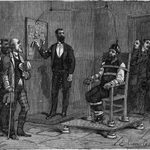REPORTS OF BOTCHED EXECUTIONS BY FIRING SQUAD
A report in the Salt Lake City Tribune takes a different view of the suggestion that there have been no botched executions by firing squad.
From Hal Schindler, “Taylor’s Death Was Quick … But Some Weren’t So Lucky Executioner’s Song – a Utah Reprise,” in The Salt Lake City Tribune, January 28, 1996:*
But on May 16, 1879, a lack of restraining straps resulted in the most bizarre, grotesque and horribly botched Utah execution on record. It was so disgraceful that one newspaper, the Ogden Junction, sarcastically reminded the state that “the French guillotine never fails.”
It all came about when Wallace Wilkerson, who killed a man in an argument about a card game in Provo, was to face the firing squad in a corner of the jail yard. As the hour neared, Wilkerson strode from his cell dressed in black broadcloth and wearing a white felt hat. In his left hand he carried a cigar, which remained with him to the last.
Witnesses noticed “he exhibited unmistakable effects of liquor.” The condemned man insisted on not being tied to the chair and he refused a blindfold. “I give you my word,” he said, “I intend to die like a man, looking my executioners right in the eye.”
The sheriff protested, explaining that the sharpshooters would be concealed in a shed 20 feet distant. Wilkerson pleaded, and the sheriff relented. He placed a white, 3‑inch patch over the condemned man’s heart, stepped back and signaled the shooters.
Wilkerson heard the muted command, “Ready, aim … ” and drew up his shoulders as if to brace himself for the fatal moment. The guns fired; four heavy slugs tore into the condemned man. With the impact, Wilkerson leaped out of the chair and jumped forward “five or six feet.” He crashed to the dirt and turned his head downward to his chest.
“Oh, my God! My God! They have missed,” he screamed.
A doctor and several witnesses rushed forward. As Wilkerson writhed on the ground in full view of some 20 spectators, it became apparent the bullets had not struck his heart.
By straightening in his chair, he had raised the target and the shooters were misdirected. Three slugs touched the target, but were well above the vital spot; the fourth bullet struck six inches from the others and shattered Wilkerson’s left arm.
It was 27 minutes before he could be pronounced dead.
In September 1951, Eliseo J. Mares became the second condemned man to suffer the consequences of a botched execution.
Mares was the first prisoner to be put to death in the new prison at the Point of the Mountain. The old penitentiary in Sugar House had been the execution site since 1900; before then the sentences were carried out in counties where the crime took place.
When Mares was shot, newspaper stories carried the barest of details. Not until 25 years later, in a reminiscence by one of the witnesses, Salt Lake Tribune reporter Clark Lobb, was it disclosed that Mares “died silently and horribly.” Two of the four bullets fired from 15 feet away struck Mares in the hip and abdomen. It was several minutes before the prisoner was declared dead.
*excerpts reported in Connor Friedersdorf, “Utah May Bring Back the Firing Squad,” in The Atlantic, March 11, 2015:
125 Years Ago, First Execution Using Electric Chair Was Botched

On August 6, 1890, New York executed William Kemmler. It was the first time ever a state used the electric chair to carry out an execution. Proponents of electrocution — including Thomas Edison — touted the new method as quick, effective, painless, and humane: the same arguments later used by legislators to support lethal injection and execution by nitrogen gas. In May 1890, the U.S. Supreme Court rejected Kemmler’s challenge that the electric chair was cruel and unusual punishment. “Punishments are cruel when they involve torture or a lingering death,” the Court wrote. But it said the New York legislature in enacting the electric chair statute had intended “to devise a more humane method” of execution and “presume[d] that the legislature was possessed of the facts upon which it took action.” The execution proceeded. According to the Buffalo News, Kemmler — who was intellectually disabled — asked corrections officers: “Don’t let them experiment on me more than they ought to.” After an initial 17-second administration of high-voltage electric current, a doctor declared Kemmler dead. Then Kemmler let out a deep groan and witnesses reportedly screamed “Turn on the current!” Reports of the execution say that “After 2 minutes the execution chamber filled with the smell of burning flesh. 2 of the witnesses fainted. Several others were overcome with severe attacks of nausea.” Newspapers called the execution a “historic bungle” and “disgusting, sickening and inhuman.” States have carried out 158 executions by electric chair since 1973. 10 were botched. Virginia was the most recent state to use the electric chair, executing Robert Gleason in January 2013.
(S. Meehan, “Aug. 6, 1890: Buffalo man is first to be executed by electric chair,” The Buffalo News, Aug. 6, 2015; “Kemmler’s Death by Torture,” New York Herald, Aug. 7, 1890; In re Kemmler, 136 U.S. 436 (1890).) See History of the Death Penalty and Methods of Execution.


